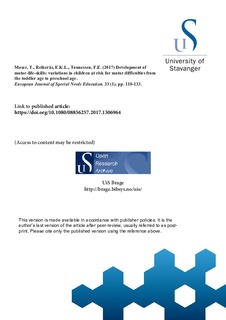Development of motor-life-skills: variations in children at risk for motor difficulties from the toddler age to preschool age
Journal article, Peer reviewed
Accepted version
Permanent lenke
http://hdl.handle.net/11250/2479095Utgivelsesdato
2017-03Metadata
Vis full innførselSamlinger
Originalversjon
Moser, T., Reikerås, E.K.L., Tønnessen, F.E. (2017) Development of motor-life-skills: variations in children at risk for motor difficulties from the toddler age to preschool age. European Journal of Special Needs Education. 33 (1), pp. 118-133. 10.1080/08856257.2017.1306964Sammendrag
This article explores variations in development of everyday motor-life-skills in 661 children (329 girls and 332 boys) in Norwegian kindergartens of ages 2:9 (T1) and 4:9 (T2) years:months. The particular focus is on children at risk for problems in motor development (the 10% weakest children in the sample). The methodological approach chosen is authentic assessment, applying the Early Years Movement Skills Checklist (EYMSC). All correlations between motor-life-skills at ages 2:9 and 4:9 are statistically significant (p < 0.01), varying between r = 0.26 to 0.38 for the four section scores of EYMSC (Self-help skills, Desk skills, General classroom skills and Recreational and playground skills) and r = 0.39 for the EYMSC total score. The group composition of children assumed to be at risk for motor difficulties changes considerably between ages 2:9 and 4:9. Approximately, two-thirds of the 10% weakest at T1 do not belong to the 10% weakest at T2. Logistic regression failed to identify children at risk at T1 being among the 10% weakest at T2. However, for two sections of EYMSC (Self-help skills; Recreational and Playground skills), it was possible to distinguish between stable and flux groups.
Beskrivelse
This is an Accepted Manuscript of an article published by Taylor & Francis in the European Journal of Special Needs Education on 31.03.2017, available online: http://www.tandfonline.com/10.1080/08856257.2017.1306964.
